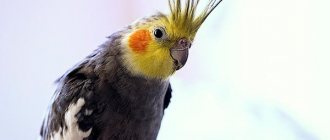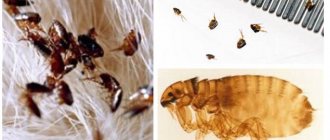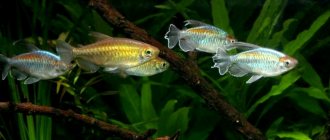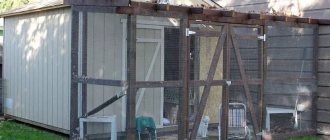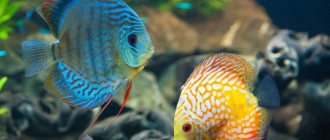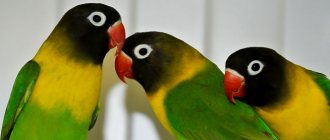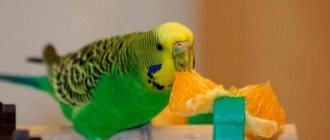Description
The habitat of parrots is the tropical and subtropical regions of America and Australia. Various species have their own special, unique color, size, and habits. These birds have won the hearts of bird lovers. And all thanks to their cheerful disposition, curiosity, restlessness, and positivity that they radiate to others.
Woodpeckers
This breed is considered one of the smallest among small parrots. This bird was first discovered in Papua New Guinea. It can also be found in the Solomon Islands. It weighs no more than 12 grams, and its size is 9 cm.
There are also large specimens, reaching 10 cm, weighing up to 15 grams. Nature, in order to protect them from predators, endowed them with green plumage. The underside of the body is lighter than the top; the feathers have a black edging along the edges.
Females have a light yellow head color, while males have a dark head color. All representatives of this breed have a blue tail, with a black stripe along the edges. Almost nothing is known about this species. There are several subfamilies of woodpeckers that have not yet been studied at all. They do not take root at home. They can mainly be found in the zoo.
Parrots for children and beginners
Birds are kept for children. The birds are unpretentious in care and maintenance, the child learns responsibility. The future pet is chosen based on financial capabilities, living space and the age of the child. Errors are possible. At the persistent requests of a child, sometimes a large parrot is purchased. It ends badly: the bird returns to the pet store or to the breeder. This is the best case scenario. At worst, she is rarely remembered and kept in disgusting conditions. The pet dies due to poor care.
To avoid such a situation, it is advisable to familiarize yourself with the breed of bird you plan to purchase.
Who to choose for a small apartment, a cockatiel or a budgie? The child insists on cockatiel. This bird requires a large cage and quite expensive food. Will adults be able to support it? Is there a secluded corner for a cage in the apartment? Will the cockatiel be comfortable there? By answering these questions, parents will be able to make a final decision.
Important! A budgerigar would be an ideal pet for children. He is small, cheerful, and learns to talk easily. With good care, it can live up to 15 years.
Which parrot is better to have at home if the space allows you to keep a large bird, but there is no experience in keeping it? There is only one recommendation - a budgerigar. A novice “poultry farmer” can take care of him.
Budgerigars
Which parrot is best for a child, other than a budgie? The bird is good for its unpretentiousness and cheerful disposition. Budgerigars quickly become tamed and make contact easily. Able to remember and reproduce 150-200 words. With regular training, they will delight the little owner with their achievements.
The parents decided to get a parrot for their child. How to choose a budgie?
- The male, up to 6 months old, has a pink-violet beak. With age it turns blue. The older the bird, the brighter the blue color of the beak;
- In young females, the color of the beak is soft pink. In individuals older than six months, it becomes darker. An adult or old bird has a brown beak;
- There are black waves on the heads of young birds. After 4 months they disappear or become almost invisible;
- The parrot's cloaca area should be clean. If the bird's feathers and cloaca are contaminated with droppings, the parrot is not healthy;
- A healthy bird is active. She chirps cheerfully and pesters her cage neighbors. A ruffled parrot with dull or closed eyes is sick.
- If you plan to further train your parrot to talk, the male is ideal for this. Females chat less often.
- The cost of a bird ranges from 800 to 1500 thousand rubles. Males are more expensive than females.
cockatiels
The choice of a parrot for a home is based on the desire of the future owners and the ability to keep this or that bird. If you want to buy a large parrot, but there is too little space in your apartment, the cockatiel will be an alternative.
The parrot is classified as medium. It is slightly smaller in size than a pigeon. Cockatiels are mostly gray in color. But light yellow and ivory-colored individuals can be found. The birds have a funny crest on their heads. Males differ from females in their red “blush” on their cheeks and their massiveness. Female cockatiels are rather small, they have pale cheeks and a shorter crest. A Corella will cost about 3500-4000 thousand rubles.
Lovebirds
How to choose lovebirds? There are several subspecies: pink-cheeked, masked, Fisher's, black-cheeked, black-headed, collared. The list can be endless. The most common are rosy-cheeked, masked and Fischer. They differ in appearance.
The highlight of pink-cheeked birds is the color of their heads. The main background is most often green. The head is green-white. The cheeks are pale pink.
The masked lovebird is the most beautiful. The upper part of the head, back and chest are bright yellow. The muzzle is black, with a clearly visible red beak. Large white eyes with black pupils complete the image of the bird. The lower back and body are green.
Fisher's lovebird can be green or yellow. Its muzzle is painted bright orange or red. The beak is yellow or red. Of all the subspecies, this is the most expensive.
Males and females cannot be distinguished by appearance. It is acceptable to keep one parrot, but it will be sad and lonely. He has been wary of his owners all his life. He sits on your hand if you really try and train him, flies around the room, and responds to his name. However, he doesn’t like unnecessary touches. A solitary lovebird is more comfortable in a cage than with a person.
A couple of lovebirds are quite noisy at home. Birds are busy only with themselves, “talking” in their own language. They scream loudly, and the scream is quite disgusting. Having a child is not an option. Suitable for an adult or a married couple without children. Not everyone can withstand constant screaming. A pair of lovebirds can cost up to 10,000 - 12,000 thousand rubles.
We recommend reading: Varieties of feeders for parrots
Lovebirds
This species is distinguished by its bright color and restless temperament. The main color is green, which goes beautifully with:
- pink;
- yellow;
- in red.
Lovebirds of pure white, deep yellow, and cobalt colors have also been bred.
The size of the bird's body is about 17 cm. To teach lovebirds to talk, you will have to put in a lot of work. But this is compensated by their activity and cheerfulness. Looking at them, you become filled with optimism.
Lovebirds are always kept in pairs. They have a touching attitude towards their partner, as the name itself suggests. Mostly they sit huddled closely together. In captivity, these parrots can live 20 years.
Other types of small parrots
It is worth noting that there are more common breeds of parrots that are also small in size. These include:
- Budgerigars.
- Lovebirds.
Wavy plants are distinguished by their beauty. This species is one of the most famous that are used as pets. They are not very large in size and the body length ranges from 17 to 23 cm. The wings of the birds are about 10 cm, the tail is about 9 cm, the weight of the birds does not exceed 45 grams. Due to their large tail, the birds seem quite large, although this is not the case.
In nature, this species is also green in color, although their head and throat are yellow, and there are characteristic purple spots on the sides of the head. The back of the head of birds has brown fibers that smoothly transition to the back.
Today the breed is widely bred using artificial methods. Due to this, the breed can have different colors and shades.
If we talk about lovebirds, then the homeland of this species is Madagascar, as well as some other islands of Africa. The name of the birds comes from the fact that they prefer to live and be in pairs, and if there is no pair, then simply in a flock. Parrots grow to approximately 17 cm in length. Such birds live for about 15 years, sometimes up to 20.
The view itself has bright colors. Their feathers are a rich green color, and some parts of the body have red, blue and yellow hues.
This species is also used as a pet. It is better to keep them in pairs, but breeders should not hope that they will talk.
Lovebirds
Wavy
Only a dense person does not know about this breed of parrots. Wavy is often found in city apartments and houses. The birds are different:
- cheerfulness;
- activity;
- friendliness.
You can buy them at the market or at a pet store. The price is available to a wide range of buyers. Budgerigars easily copy human speech. This breed can be kept in large numbers, in pairs or alone. They love it when they get a lot of attention.
If the bird lives alone, it will quickly learn human conversational speech. But males are considered more capable than females in the ability to imitate sounds, so some owners prefer boys.
The size of the parrot's body reaches 19 cm. They can choose a cage that is not very large. It is advisable to let him fly every day. It's good for your health. By nature, birds have green plumage. The work of breeders has enriched the breed of budgerigars with a variety of colors, from which there are more than 200 colors. Under good conditions, budgies live 15-20 years.
The best breeds of talking parrots
How they differ: Active, love attention. You can teach not only to speak, but also to sit on your shoulder or fingers. They make less noise than other brothers. Can be kept in a cage in pairs.
Speech Ability: Can remember up to 150 words. The speech is not very clear and loud, but the owners will understand the chirping of their pets.
Size: Up to 18 cm
Weight: 30 - 40 g
Lifespan: From 5 to 15 years
Price: From 700 rubles
How they differ: They quickly get used to the cage. You can start one if you have small children at home. The cockatiel may be of medium size, but if it bites, it doesn’t hurt.
Speech ability: It is possible to teach speech, but they will not remember as many words as budgerigars, and it will take more time. They pronounce all words in a row indiscriminately. The pronunciation resembles a grumbling sound.
Size: 30 – 33 cm
Weight: 80 - 100 g
Lifespan: From 8 to 15 years
Price: From 2500 rubles
How they differ: It has a very variegated color, with males having a more saturated color. They are considered calm and quiet birds. Unpretentious in content. They can imitate the singing of different birds.
Speech ability: Remember about 10 words. They sing well, whistle various melodies and sounds, and can meow, croak, and bark.
Size: 25 – 35 cm
Weight: 90 - 120 g
How long does it last: From 20 to 30 years
Price: From 3000 rubles
How they differ: The coloring of this breed is not as bright as that of other parrots: the gray is a discreet gray color. But they are valued not for their appearance, but for their ability to speak. They quickly get used to their owners and get offended if they are shouted at. This causes them to become stressed and may begin to pluck their feathers.
Speech Ability: They do not just shout out individual phrases, but are able to conduct a dialogue. Words are pronounced clearly, better than other breeds. Among the Grays there were birds that memorized up to 2000 words!
Size: 30 – 35 cm
Weight: 400 g
Lifespan: Up to 50 years
Price: From 70 thousand rubles for a red-tailed Gray. Brown-tailed ones are cheaper, but they speak worse.
How they differ: The breed is not noisy, but whimsical. It must be protected from drafts. They love to communicate. Owners need to pay special attention to these birds.
Speech ability: Remember about 60 - 100 words. Can speak in short sentences. Amazons are self-taught. They often mutter something under their breath, or rather under their beak, and then they can give out phrases that no one specifically taught them.
Size: 35 – 41 cm
Weight: 400 – 700 g
Lifespan: From 15 to 50 years
Price: From 60 thousand rubles
Passeriformes
This is a small breed of parrot. Their body measures 14.5 cm. If you are going to get this type of pet, you can get several advantages:
- They are easy to care for.
- They are distinguished by their friendliness.
- They quickly learn to speak.
- Playful, attached to the owner.
- Quiet.
However, there are shortcomings in the content. No more than 2 individuals are usually placed in a cage, since the passerine parrot breed is distinguished by its aggressive disposition. They live at home for up to 20 years.
Types of parrots for home keeping
There are approximately 330 species in the parrot family, most of which have been successfully domesticated by humans . They say that the first parrot saw the expanses of cold Russia in 1490, arriving from sunny Italy as a gift to Sophia Paleologus, the wife of Tsar Ivan the Great.
In city apartments there live different parrots: small, larger and huge ones, whose cages are more like aviaries. The smaller the bird, the shorter its life span. The longest-livers of the parrot kingdom are cockatoos. They also retain an interest in the sexual side of life and reproduction longer than any other parrot.
Large parrots
Showy and one of the most impressive (up to a meter in length) macaw parrots are distinguished by their quarrelsome character, which, combined with a strong beak and shrill voice, promises noticeable difficulties in keeping them at home. They have average abilities for onomatopoeia, but good ability to learn circus tricks. Smaller macaws are also noisy, but they are much easier to care for.
Grays not only perfectly imitate speech and extraneous sounds (household appliances, bird calls), but also associate spoken words with objects. In addition, it has been proven that with directed training, gray parrots distinguish between the concepts of color, shape and serial number.
This is interesting! Grays have an easy-going disposition, making it easy to become attached to their owner.
Half-meter-long cockatoos, whose heads are adorned with a colored crest, which when unfolded look like a punk mohawk, also easily get used to their owners. These parrots can also repeat sounds and have a loud, squeaky voice. A remarkable artistic gift is manifested, in particular, in masterful control of the body: cockatoos crouch and bow, straighten and fold their crest, run and spin.
Amazons, growing to almost 0.5 m, have also proven themselves positively in urban conditions - they are quite calm and not without abilities. These birds learn several dozen words, and certain species (yellow-headed, blue-fronted and white-headed) are well trained.
Medium sized parrots
Tree loris parrots are peaceful and can copy a person’s voice, memorizing several dozen words . These colorful birds are readily tamed, but they are selective in their food supply, and also need elevated ambient temperatures.
Pied rosella and cockatiel (a relative of the cockatoo) are among the popular species due to their unpretentiousness, sociability and funny appearance: cockatiels also have small crests. Both species learn a decent set of frequently spoken words, but differ in the timbre of their voice: the rosella reproduces melodies gently but loudly, while the cockatiel reproduces melodies monotonously and squeakingly.
Ozherelovye, or ring-necked parrots (accustomed to cages almost 3 thousand years ago) do not require special conditions. Over such a long period of time, the birds have completely settled into society and are quickly getting used to their new owner. The bird has a cheerful disposition, complemented by cheerful bright colors (about 300 color options). This talker remembers/reproduces many sounds and speaks about 250 words.
Small parrots
In this category, there is no doubt that budgerigars have no equal. Their height limit does not exceed 20-23 cm. Small size, rapid reproduction, unpretentiousness and friendliness have made birds the absolute leaders in the number of those kept in captivity (among parrots).
They are kept alone, in pairs and even in flocks, depending on the purpose of acquisition. A male and a female are needed to produce offspring, and loners are needed, most likely, for entertainment, since in the absence of company they are more willing to start talking. The vocabulary of wavy birds is usually not amazing, but they master simple tricks and perfectly imitate canaries, singing and whistling.
Because they don't have menacing beaks, budgies can be adopted by families with small children. Birds are sociable and, with the right approach, do not cause any inconvenience to the owner. Breeders have bred a huge number of varieties (dissimilar in plumage pattern and coloring) adapted for indoor living.
This is interesting! The cheapness of wavy flowers is another significant reason for their sustainable popularity.
Cell
It is necessary to purchase a rectangular-shaped home with a retractable bottom, this makes it easier to clean. The size should be such that the parrot can freely spread its wings. The cage is equipped with:
- Wooden poles. The diameter should be comfortable for gripping with your paws.
- Drinking bowl.
- Two feeders.
- Sepia, mineral stone.
- Wooden toys.
Despite the long-established habit of hanging a mirror in a cage, there is still no need to do this. It will interfere with the parrot’s speech production, since the lack of reaction to his communication with the reflection may make him sad. The cage is placed near the wall, at such a height that the pole is at eye level of the owner.
Your pet needs time to adapt. It is better to release it from the cage two weeks after purchase.
Nutrition
Small parrots have a fast metabolism, so feeding is done every three hours. It is necessary to ensure that there is always food in the cage. There should be variety in the diet. Their main diet is grains. Also give:
- Vegetables.
- Fruits.
- Greenery.
- Boiled eggs.
- Porridge cooked in water.
- Skim cheese.
- Seeds.
Your pet's menu should consist of these products.
There are two feeders. One for grains, the other for vegetables, fruits. But not all human food can be given to a parrot. Rye breads, herbs, sugar, salt, meat, fish, and dairy products are contraindicated for these birds.
Small parrots are given twigs or young shoots of fruit trees in their cage. This is beneficial for their body and is necessary for grinding down their beak and claws.
